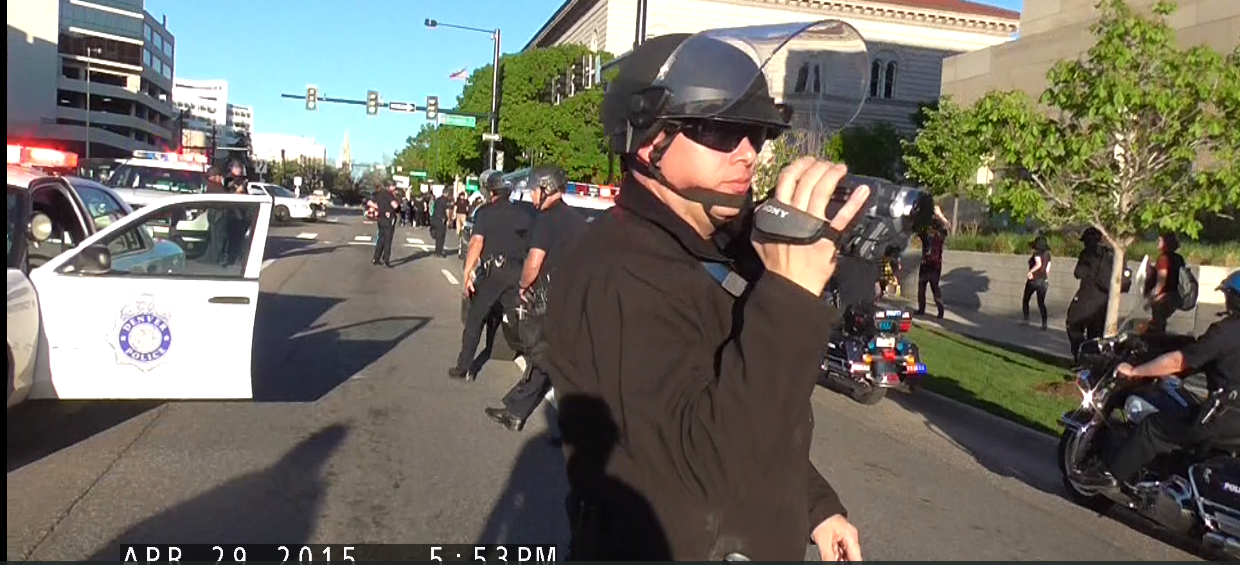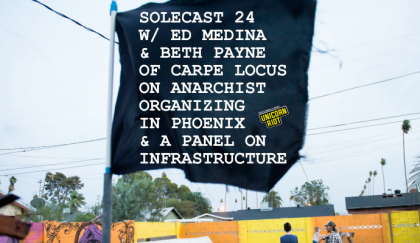One Year Later: A Cop’s Eye View of Protest Repression in Denver
Denver, CO – One year ago today, protesters in Denver took the streets in solidarity with the uprising taking place in Baltimore in response to the police killing of Freddie Gray. The Denver Police Department (DPD) forcefully repressed the march as soon as it began, ramming protesters with motorcycles, deploying large quantities of pepper spray, forcefully confiscating a banner and making 11 arrests, several of which landed demonstrators in the hospital.
Earlier this month independent journalist Jessica Benn filed a federal civil rights lawsuit against DPD District 6 Commander Antonio Lopez, alleging that Lopez stole her cell phone out of her hand of as she was filming DPD’s brutal arrest of her husband Jesse.
According to DPD’s After Action Report for April 29, 2015, 114 officers were deployed for a total of 431 personnel hours. If we assume all 114 personnel present were receiving the median DPD officer’s hourly pay of $31.51, this would bring the cost of approximately 5 hours of protest policing to $13,580.81. The actual figure may be significantly higher, as this estimate does not include overtime pay, or the higher salaries of those above the rank of Officer such as Technicians, Sergeants, Commanders, etc.
Exactly a year after this remarkable event of police repression in Denver, Unicorn Riot is releasing videos taken by the police during the protest, as well as many relevant police documents. We obtained these videos and documents through open records requests along with other methods. Our decision to request footage from handheld police video cameras was inspired by a project using Boston Police protest surveillance footage by reporters at Muckrock, a website which facilitates and archives open records requests and records-driven journalism.
We found it particularly interesting to compare the video with the police reports written to justify arrests. We noticed many inconsistencies and given how most of the charges filed against protesters in connection with this event ended up being dropped, we weren’t the only ones who noticed.
Police reports obtained by Unicorn Riot describe numerous acts of assault committed by protesters towards police, however, these claims have been disproven and we could find no direct evidence of any assaults (other than those committed by police) in our extensive examination of the evidence. The language of “assault on an officer” appears to be deliberately constructed to legitimize violence against anti-police protesters. One protester’s arrest report contains a “caution” labeling the person as “assaultive towards police” and “violent” even though they were not charged with assault or any other violent crime.
Several parents met with the Office of the Independent Monitor, Denver’s police watchdog, to formally complain about their children being pepper-sprayed by DPD. A response sent by DPD to complaints filed by protesters cites acts of speech – a message on a sign, as well as a post allegedly made on Facebook before the march – as justification for the use of chemical weapons against marchers.
DPD Technician Jeff Motz, who murdered unarmed Dion Avila Damon by shooting him seven times earlier this month, was working in the Metro/SWAT unit during this protest. Motz personally carried out at least two arrests of protesters on April 29, 2015, including one in which the arrestee told us that the arresting officer (later discovered to be Jeff Motz) intentionally placed flexcuffs too tightly on their wrists. The over-tightening of flexcuffs is a known torture tactic, often used by Denver police during protest arrests, that can cause intense pain, loss of circulation and nerve damage.
“I had a bruise in the middle of my back from where he [Jeff Motz] kneeled on me to keep me pinned to the ground while I was being cuffed. It also felt like he was gonna break my shoulder with the way he pulled my arms around to cuff me, even though I was lying completely limp/still and complying with police orders. My zipties were on so tight that I was losing feeling in one of my hands by the time I was put in a police van. I asked them to make adjustments before we were driven away, but I was ignored. When we got to the station and they finally decided to remove the flexcuffs, they were so tight that the cutters couldn’t fit underneath and they broke the skin on my wrist trying to cut them out.“
-Ross Swirling, a protester arrested on 4/29/15 who was charged with Assault and Destruction of Public Property. Both charges were later dismissed with prejudice.
The handheld police camera footage we acquired via open records request is incomplete. While we could prove the presence of a second handheld camera, we were told that footage could not be released due to “technical difficulties.” The portion of the march when most of the arrests as well as most of the use of force by police took place is missing from the footage. The footage we do have is shaky, low resolution, and poorly shot. The officer with the camera appears to film protesters and bystanders at random, in a way that many clearly took to be antagonistic, responding to being filmed with “fuck you” or “you on the video, fuck you too” as they appear on screen. Towards the end of the video, one protester passing the videographer can be heard to remark “that’s a pawn shop camera.” At one point, the cameraman appears to have an artistic side, taking a moment to film a plane streaking across the bright blue sky.
These videos also allow a rare, intimate look behind police lines during protest crowd control. At the beginning piled up gear is visible in the back seat of a squad car, and later in the video tactical conversations happening between Commander Lopez and members of Metro/SWAT can be overheard. Officers can also be heard joking and laughing, as well as helping each other get their stories straight for the arrest paperwork.
Many of the maneuvers, strategies and tactics used by DPD on April 29, 2015 are covered in the Denver Police Crowd Control Manual, which we published unredacted earlier this year after receiving a leak. The manual specifically allows the use of “pain compliance” on passively resisting demonstrators and also outlines the use of undercover officers or “shadow teams” to gather intelligence and target protesters for arrest.
Watch the full videos and view/download documents below.
width=”400″ height=”300″ frameborder=”0″ allowfullscreen=”allowfullscreen”>Source documents acquired for this article:
Denver Police Operations Plan 4/28/15 (Redacted)
Denver Police After Action Report 4/28/15 (Redacted)
Denver Police Operations Plan 4/29/15 (Redacted)
Denver Police After Action Report 4/29/15 (Unredacted)
Denver Police Incident Detail Report 4/29/15 (Unredacted)
Denver Police Arrest Documents 4/29/15 (Redacted)



